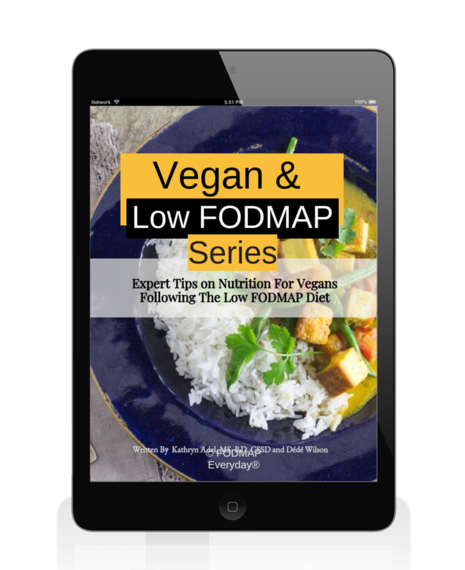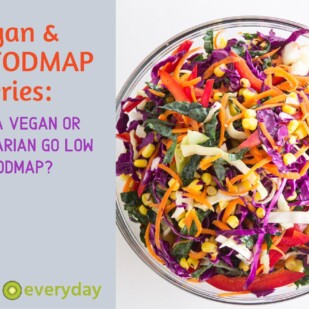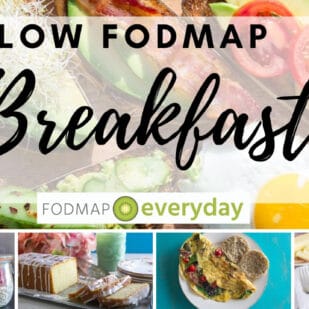Welcome to our Vegan & Low FODMAP Series!
If you are wondering if you can follow the low FODMAP diet while also following a vegan diet this series is for you.
Written by 2 of our Success Team Member Dietitians, Rachel Meltzer Warren MS, RDN and Kathryn Adel MS, RD, CSSD and FODMAP Everyday Co-Founder and Food Expert, Dédé Wilson.
We cover everything:
- Which are the best low FODMAP ingredients to keep you happy and healthy.
- How to make sure you get your nutritional needs met.
- And how to convert low FODMAP recipes into low FODMAP vegan recipes that work!
Be sure to read the other two articles in the Vegan and Low FODMAP Series:
- Vegan & Low FODMAP Series: Can a Vegan or Vegetarian Go Low FODMAP?
- Vegan & Low FODMAP Series: Converting Conventional Low FODMAP Recipes To Vegan Recipes
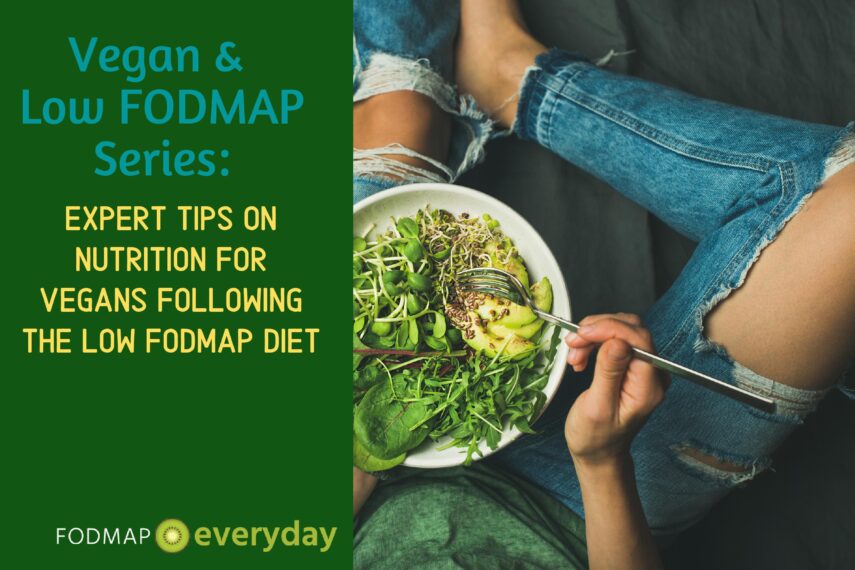
Expert Tips For Vegans Following The Low FODMAP Diet
You might find that low FODMAP vegan recipes are harder to find. But the good news is that it is often possible to simply make a few tweaks to a recipe to make it vegan friendly! We have created a companion article, Converting Conventional Low FODMAP Recipes To Vegan Recipes, that we suggest you read in tandem with this article.
You Can Follow The Low FODMAP Diet & Eat Vegan
Can Vegans Follow The Low FODMAP Diet? Although a vegan diet has many benefits, it can sometimes cause digestive symptoms related to Irritable Bowel Syndrome (IBS). This is because many plant-based foods are high in FODMAPs. Following a low FODMAP diet and a vegan diet together can seem difficult and discouraging, since you may feel that you have to eliminate all the foods that you are used to eating.
It is totally possible to follow a low FODMAP and a vegan diet at the same time. Of note, the Elimination Phase should only be followed for a short period of time (ideally two weeks), concurrent with a vegan diet. After that you should start the FODMAP reintroduction trials by Challenging new foods. After all, the ultimate goal, whether you are vegan or not, is to be able to eat as broadly as possible without triggering IBS symptoms. This is optimal for your microbiota and long-term gut health.
Educate Yourself & Plan
It would be a good idea to get familiar with the low FODMAP diet before you start trying to combine a vegan diet and a low FODMAP diet to avoid eating high FODMAP foods by mistake, which would prolong the Elimination Phase. Also, it is important that you plan your meals and snacks properly to avoid nutritional deficiencies. Don’t hesitate to seek help from a Registered Dietitian who is experienced with the low FODMAP diet.
In this article, and our companion articles, we will provide you with the information you need on how to avoid nutritional deficiencies while being on a low FODMAP vegan diet and how to transform standard low FODMAP recipes to vegan low FODMAP recipes.
Keep An Eye On Nutrients
Protein
Attempting to meet your protein needs while following a low FODMAP vegan diet can be difficult. Nuts, seeds and beans often play primary roles in a vegan diet, but the variety and amounts of these protein-rich ingredients have to be monitored for FODMAP content.
For people with higher protein requirements, such as athletes, it may be helpful to use a protein powder supplement, as long as you read the ingredient list carefully to make sure it doesn’t contain any ingredients that are high in FODMAPs.
- The average protein requirement for an adult is 0.8 g to 1 g per kg of body weight.
- An averagely active person weighing 75 kg should therefore consume between 60 and 75 g of protein daily.
- Older adults have higher protein needs, about 1.2g per kg of body weight.
- Athletes also have higher protein needs, between 1.2 to 2 g per kg of body weight depending on the type of sport.
You might be interested in reading: All About Low FODMAP Meal Replacements & Protein Shakes
We have a helpful article written by Monash University trained RD Vanessa Cobarrubia on low FODMAP drinks and shakes and we also have our Shopping Lists that contain dozens of ideas. They are not exclusively vegan, but these resources will be of help.
Vegan Proteins
The following table provides a list of vegan foods that are low in FODMAPs and high in protein.
| Food (low FODMAP serving size) | Protein content |
|---|---|
| Firm or Extra-Form Tofu (170 g) | 14 g |
| Tempeh (100 g) | 18.5 g |
| Frozen edamame, without the shell (½ cup or 90 g) | 10 g |
| Canned lentils, rinsed (¼ cup) | 4 g |
| Canned chickpeas, rinsed (⅓ cup) | 3.5 g |
| Chia, hemp, sunflower and pumpkin seeds (2 tbsp.) | 4 to 7 g |
| Flax seeds (1 tbsp) | 2 g |
| Almonds, walnuts, Brazil nuts, pecans (10 nuts) | 3 to 4 g |
| Almond butter (1 tbsp) | 3 g |
| Peanuts (28 g or 32 nuts) | 7 g |
| Peanut butter (2 tbsp.) | 7 g |
| Macadamia nuts (40 g or 20 nuts) | 3 g |
| Quinoa (1 cup cooked or 195 g) | 9 g |
| Brown rice (1 cup cooked or 206 g) | 5 g |
| Millet (1 cup cooked or 180 g) | 6 g |
| Oats (½ cup or 52 g) | 5 g |
Note on lentils: Please refer to our Explore An Ingredient: Lentils for complete information on what the Monash app lists for volumes and weights of canned, drained lentils and what we found in our Test Kitchen.
Plan For Prebiotics
Prebiotics are a type of dietary fiber that is beneficial to one’s microbiota and gastrointestinal health by selectively promoting the growth of good bacteria. The low FODMAP diet restricts the consumption of many foods that are rich in prebiotics, such as fructans and galacto-oligosaccharides (GOS) which are prebiotic fibers.
In the long term, these restrictions can negatively affect the gut microbiota by reducing the amount of good bacteria present in the gut. This is why it is recommended to reintroduce high FODMAP foods and to avoid following the Elimination Phase of the low FODMAP diet long term.
During the Elimination Phase of the low FODMAP diet, it can be beneficial to include some sources of prebiotics. Many foods rich in prebiotics can be low in FODMAPs provided they do not exceed the recommended portion. Those include kiwis, bananas, rhubarb, cabbage, canned lentils and chickpeas, flax and chia seeds, almonds, hazelnuts, oats and buckwheat.
Get Your Vitamin B12!
You need vitamin B12 for various body functions including to form DNA, make healthy blood cells and keep nerves working properly. Vitamin B12 is only found in animal based food sources with the exception of nutritional yeast (like Bragg’s) which you can add to various recipes.
Vegans should take a vitamin B12 supplement (in the form of cyanocobalamin), either 25 to 100 ug per day, 1000 to 1200 ug twice a week or 2500 ug once a week. Your RD can help tailor your intake amount.
Be Iron Strong
Iron is a mineral that is important for good health and carries oxygen to all parts of your body. Iron requirements are 8 mg per day for all men and women 51 and older, but 18 mg per day for women 19 to 50 years of age and are even higher during pregnancy and for athletes.
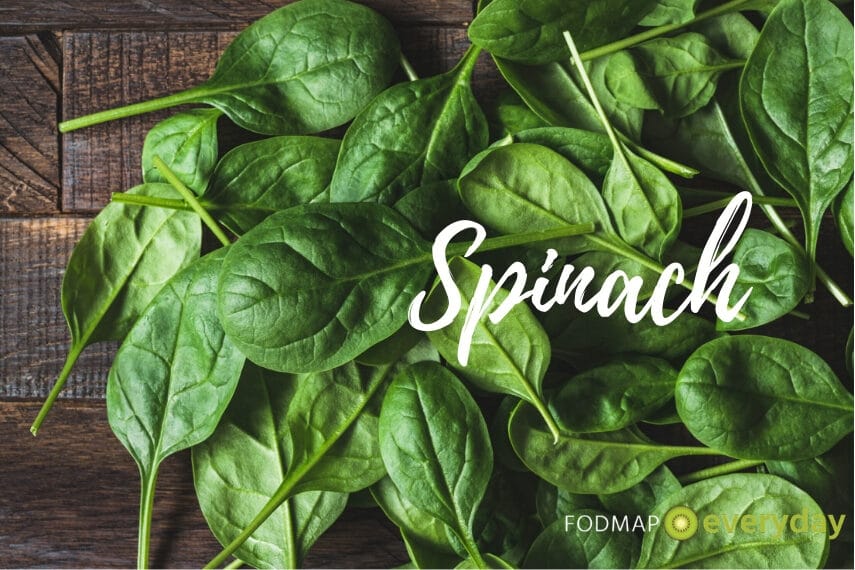
In addition, vegans should consume about 1.8 times more iron due to the lower bioavailability of non-heme iron from plant foods. Thus, you should pay particular attention to integrating low FODMAP sources of iron with each meal (fortified gluten free cereals, oatmeal, spinach, tomato purée, canned lentils, canned chickpeas, firm tofu, pumpkin seeds, etc.) and help optimize its absorption by adding a low FODMAP source of vitamin C (broccoli, red bell peppers, common tomatoes, strawberries, kiwis, citrus fruits, etc.) while avoiding consuming tea and coffee with meals, which can decrease the absorption of iron.
For women between the ages of 19 and 50, it would be a good idea to take a multivitamin supplement with a high iron content such as a prenatal multivitamin. Our WalMart and Whole Foods Shopping Lists have many low FODMAP supplements listed.
Calcium Intake Is Important
Calcium is essential for bone health but is also used in other parts of your body, for example to help your muscles work and your heart to beat. Calcium requirements are 1000 mg per day for adults aged 19 to 50 and 1200 mg per day for adults aged 50 years and over.
One way to achieve these recommendations is to consume two to three servings of fortified drinks per day like unsweetened almond milk, rice milk, macadamia milk, quinoa milk or pea milk. Pea milk has not been lab tested as of this writing, but the Ripple brand appears to be low FODMAP based on ingredients and to include calcium-rich plants such as cabbage, canned lentils and chickpeas, nuts and seeds to your diet daily. (We contacted Ripple to ask them about the “natural flavor” used in this product and they were not able to give us any further details. Read our article How to Decipher “Natural Flavors” and “Spices” on Food Labels for the Low FODMAP Diet).
(Editor’s Note: Monash had, at one point, approved pea protein as low FODMAP. They have retracted that statement due to the fact that after testing several brands, they did not find consistency in FODMAP content. One recommendation we have is that if ingredients list “pea protein isolate” in particular, that that product would be a good bet to try. That said, we do not want to count out products that just list “pea protein”. As always, assessing your own tolerance is what is most important).
Pay Attention To Zinc
Zinc supports normal growth and development for all ages, helps strengthen the immune system, heals wounds, and also helps your body use carbohydrates, protein and fat. In the vegan diet, two factors interfere with the absorption of zinc: a high intake of phytates and the absence of animal proteins. It is important that you eat low FODMAP foods rich in zinc daily (canned lentils and chickpeas, firm tofu, nuts, seeds and whole grains such as quinoa, brown rice, oats, millet, buckwheat and teff).
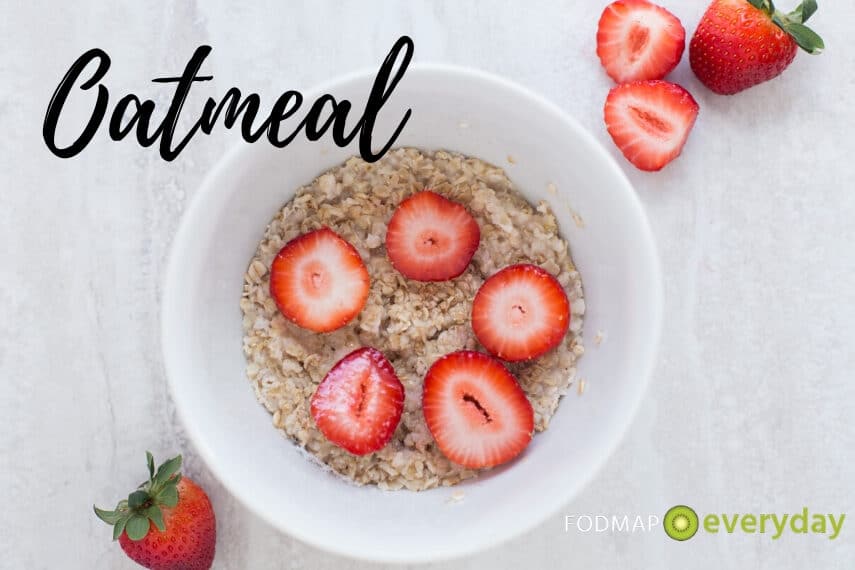
Know Your Fats! Add Omega 3
In the case of a vegan diet, the nutritional intake is often rich in omega-6 but poor in omega-3, which reduces the absorption of omega-3 and increases inflammation. To ensure adequate omega-3 intake, it is necessary to increase the amount of omega-3 consumed and to decrease that of omega-6.
The main sources of low FODMAP plant-based omega-3s are, canola, camelina and flaxseeds oils, flaxseed and chia seeds, edamame, firm tofu, and walnuts. A vegan omega-3 supplement of 2 g per day made from marine microalgae is also recommended.
Vitamin D & Sunshine
Vitamin D is mostly synthesized by the skin if it is sufficiently exposed to the sun’s ultraviolet rays. It is naturally present in very few foods. The only foods that contain vitamin D in its natural form are oily fish, shiitake mushrooms and egg yolks.
For vegans, the fish and egg yolks are out and shiitake mushrooms are low FODMAP in very limited amounts. Other sources of dietary vitamin D come from foods that have been fortified, such as milk and certain plant-based drinks.
In Northern countries, during the winter months, the skin isn’t sufficiently exposed to the sun to produce enough vitamin D, and it is very difficult to obtain adequate levels of this nutrient through foods. Vitamin D deficiency is associated with a multitude of health issues including cardiovascular disease, gastrointestinal disease, diabetes, obesity, depression, osteoporosis, a weakened immune system and an impaired sports performance.
If you live in northern countries, whether you are vegan or not, it is recommended that you take a vitamin D supplement between the months of October and April. People aged 50 years and over should take a supplement all year round.
The Takeaway
You can definitely follow a low FODMAP Diet and eat vegan at the same time! However, it does require that you pay attention to details such as serving sizes, ingredient lists and nutrient content of foods, in order to prevent GI issues and nutritional deficiencies.
Pay a special attention to nutrients mentioned in this article, and use our companion article, Converting Conventional Low FODMAP Recipes To Vegan Recipes, to help you turn recipes into vegan low FODMAP alternatives. Be sure to start the FODMAP reintroduction trials as soon as possible. If you are new to the low FODMAP diet or the vegan diet, you could highly benefit from working with a FODMAP trained and vegan savvy Registered Dietitian.
Want to see all 200+ of our low FODMAP Vegan Recipes?
Click Below!
Be sure to read the other two articles in the Vegan and Low FODMAP Series:
- Vegan & Low FODMAP Series: Can a Vegan or Vegetarian Go Low FODMAP?
- Vegan & Low FODMAP Series: Converting Conventional Low FODMAP Recipes To Vegan Recipes
- Plant-Based Nutrition and the Low FODMAP Diet
